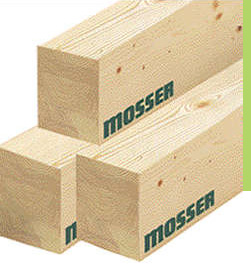Glulam,
short for glued laminated timber, is an engineered wood product. Large glulam
members are produced from smaller pieces of stress graded and seasoned timber,
known as laminates.
Glulam
originated in Germany around 1900 but didn't make its way to Australia until
the 1950s. It is now used for both structural and decorative applications.
Manufacturing
The
manufacturing process produces large and long length glulam members, which also
results in increased strength when compared to that of the individual member.
This also means that much larger pieces of timber can be produced than would
otherwise be possible with traditional solid sawn timber. Glulam is
consistently stronger than solid timber, in part due to the reduction in size
and occurrence of natural defects.
Timber
laminates used in the production of glulam are typically finger-jointed into
continuous lengths and available in a range of both softwood and hardwood
species. The thickness of the laminates will depend on the application and
species used. Prior to gluing, the laminations are accurately dressed to exact
and uniform thickness. The laminates will also be clamped together under
constant pressure until the glue has cured. Once glued, members are planed, cut
to exact size and may be coated with a water repellent sealant.
Many manufacturers
are able to produce a variety of shapes and sizes at the designer's request.
The length and shape of glulam sections is limited only by manufacturing,
transport and handling capabilities.
Australian
manufacturers generally produce deep sections with the laminates horizontal. In
Europe, glulam has been used with face and edge lamination to produce deep
sections with vertical laminations; this technique may also be used by some
Australian producers.
It is
possible to manufacture a glulam beam with higher strength laminates in areas
of high stress - such as in the top or bottom laminates of beams - and lower
strength laminates in the areas of low stress. Steel and fibre reinforcement
can also be incorporated in areas of high tensile stress and may be positioned
either parallel or perpendicular to the laminate direction.
Suitability
for structural applications
Glulam
offers many benefits when it comes to structural applications:
Large section sizes and long lengths -
glulam can be manufactured curved or straight and is often used as structural
beams. Finger jointing allows for long lengths.
Increased strength due to the laminating
process - glulam is stronger than solid timber as it has fewer natural defects
and a wider distribution. It is also comparable to steel in strength but is
much lighter.
A high degree of dimensional stability -
glulam is manufactured from seasoned timber and is therefore less prone to
movement caused by changes in moisture content. However, care needs to be taken
if they are used externally or in an environment with rapidly changing humidity
(such as an indoor swimming pool). Swelling and shrinkage may lead to splitting
or , in an extreme event, delamination of the beam.
Reliability - glulam is manufactured to
strict quality requirements from stress- graded timber of known structural
capacity. There are glulam quality assurance programs operating in Australia,
but not all manufacturers may belong to them.
Chemical resistance - glulam is resistant
to most acids, rust and other corrosive agents. Typical uses in corrosive
situations include animal hide curing complexes, fellmongerys, fertiliser
storage and swimming pools.


Комментариев нет:
Отправить комментарий